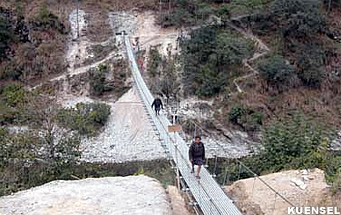 |
Bhutan Development |
|
 |
Bhutan Information |
|
|
 |
|
Development
in Trashigang
|
 |
|
Bridge
to benefit 250 households
|

|
 |
The 100-metres suspended bridge
|
For
the six villages in Thrimshing gewog, Trashigang, the anxious wait for
a bridge for the last two years will be over with the completion of a 100-metre
long suspended bridge next month.
Thungkar,
Yamkhar, Phungsing, Berdungma, Saku, and Ramjongma villages had been cut
off from the rest of the villages in the gewog after the 2004 flash flood
washed away the wooden suspension bridge over the confluence between Phekpari
and Thungkhar. |
|
According
to Thrimshing gup Phento Tshering the bridge, popularly known among the
locals as Pang zam, connected the villages to the dungkhag and gewog centres
and also to the road in Phekpari, which joins the national highway. "The
stretch is more like our main thoroughfare," he said.
 |
| The
gup explained that people were stranded without any means of transport
for about three months. Later the villagers got together to build a rope-way
which carried about two people. It was also used to transport loads.
In
winter, however, people waded across the river, along with their animals.
"But there were incidences where people and animals were washed away,"
he said. |
|
The
difficulties compelled the villagers to take a route via Khelam to reach
the Trashigang-Samdrup Jongkhar highway. "That took us about a day walking
uphill while the journey to Phekpari took not more than three hours," he
said.
The
gup said that the new bridge would benefit about 250 households in the
six villages with a population of more than 2,000 people.
According
to the bridge supervisor, construction of the new bridge had begun in the
same year the old bridge was washed away, but was delayed because of labour
shortages. "We also could not receive materials on time," he said.
Funded
jointly by DANIDA and the government, and labour support from the community,
the bridge was constructed at a cost of about Nu. 2.43 million.
| Contributed
by Kesang Dema, KUENSEL, Bhutan's National Newspaper, 2006 |

|
Suspension Bridges
Pedestrian trail bridges, mule tracks and foot trails are the main forms of transport and communication in most parts of rural Bhutan. Trail bridges over the country's deep river valleys can cut walking distance by several hours or sometimes even by more than a day. Therefore, the Government has placed high priority for the construction and improvement of trail suspension bridges and mule tracks in the rural areas since the Fourth Plan.
The construction of suspension bridge is supported by the Swiss Government through SDC/Helvetas. Swiss involvement started from 1985. Currently Suspension Bridge Program is in its sixth phase which started from July 2007 and will end in December 2010.
2008 there was a total of 390 existing bridges out of 454 constructed so far including 2 constructed with fund from the Swiss community and a 32 m span Bazam (traditional wooden cantilever bridge) over Wangchu at Changjiji. However, the 3 bridges are not included. The Bazam was constructed to mark the occasion of the Centenary Celebrations and it benefits the general public residing in either side of Wangchhu.it also benefits the students of Chang Bangdo Primary School to use the playing field situated on the other side of the river besides also allowing the city to enjoy the football matches held across the river.
Mule Tracks
In order to facilitate rural access and interconnectivity, the construction of new and improvement of existing mule tracks is supported by providing funds to the Dzongkhags for tools, plants and construction materials like explosives, etc. The implementation is being done by the Dzongkhags with community participation in terms of unskilled labor.
Under the World Food Program contribution, a total of 151 Km of mule tracks has been constructed in three Dzongkhags namely, Trashigang, Mongar and Zhemgang.
top
| more information on Bhutan |
 |
|




